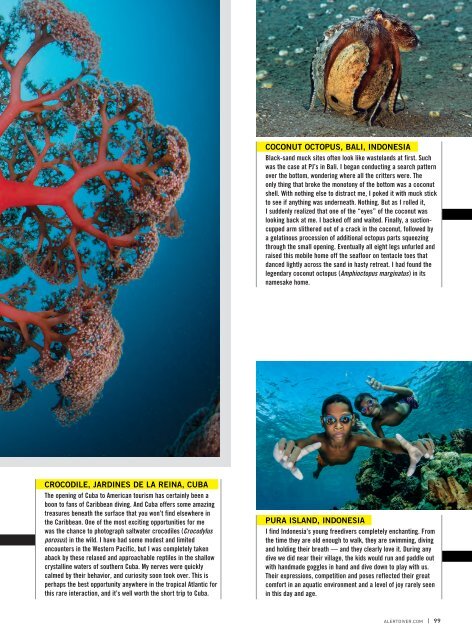AD 2017 Q4
Alert Diver is the dive industry’s leading publication. Featuring DAN’s core content of dive safety, research, education and medical information, each issue is a must-read reference, archived and shared by passionate scuba enthusiasts. In addition, Alert Diver showcases fascinating dive destinations and marine environmental topics through images from the world’s greatest underwater photographers and stories from the most experienced and eloquent dive journalists in the business.
Alert Diver is the dive industry’s leading publication. Featuring DAN’s core content of dive safety, research, education and medical information, each issue is a must-read reference, archived and shared by passionate scuba enthusiasts. In addition, Alert Diver showcases fascinating dive destinations and marine environmental topics through images from the world’s greatest underwater photographers and stories from the most experienced and eloquent dive journalists in the business.
Create successful ePaper yourself
Turn your PDF publications into a flip-book with our unique Google optimized e-Paper software.
COCONUT OCTOPUS, BALI, INDONESIA<br />
Black-sand muck sites often look like wastelands at first. Such<br />
was the case at PJ’s in Bali. I began conducting a search pattern<br />
over the bottom, wondering where all the critters were. The<br />
only thing that broke the monotony of the bottom was a coconut<br />
shell. With nothing else to distract me, I poked it with muck stick<br />
to see if anything was underneath. Nothing. But as I rolled it,<br />
I suddenly realized that one of the “eyes” of the coconut was<br />
looking back at me. I backed off and waited. Finally, a suctioncupped<br />
arm slithered out of a crack in the coconut, followed by<br />
a gelatinous procession of additional octopus parts squeezing<br />
through the small opening. Eventually all eight legs unfurled and<br />
raised this mobile home off the seafloor on tentacle toes that<br />
danced lightly across the sand in hasty retreat. I had found the<br />
legendary coconut octopus (Amphioctopus marginatus) in its<br />
namesake home.<br />
CROCODILE, JARDINES DE LA REINA, CUBA<br />
The opening of Cuba to American tourism has certainly been a<br />
boon to fans of Caribbean diving. And Cuba offers some amazing<br />
treasures beneath the surface that you won’t find elsewhere in<br />
the Caribbean. One of the most exciting opportunities for me<br />
was the chance to photograph saltwater crocodiles (Crocodylus<br />
porosus) in the wild. I have had some modest and limited<br />
encounters in the Western Pacific, but I was completely taken<br />
aback by these relaxed and approachable reptiles in the shallow<br />
crystalline waters of southern Cuba. My nerves were quickly<br />
calmed by their behavior, and curiosity soon took over. This is<br />
perhaps the best opportunity anywhere in the tropical Atlantic for<br />
this rare interaction, and it’s well worth the short trip to Cuba.<br />
PURA ISLAND, INDONESIA<br />
I find Indonesia’s young freedivers completely enchanting. From<br />
the time they are old enough to walk, they are swimming, diving<br />
and holding their breath — and they clearly love it. During any<br />
dive we did near their village, the kids would run and paddle out<br />
with handmade goggles in hand and dive down to play with us.<br />
Their expressions, competition and poses reflected their great<br />
comfort in an aquatic environment and a level of joy rarely seen<br />
in this day and age.<br />
ALERTDIVER.COM | 99









